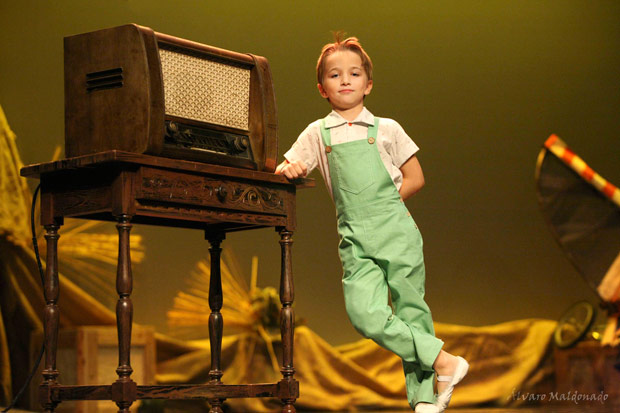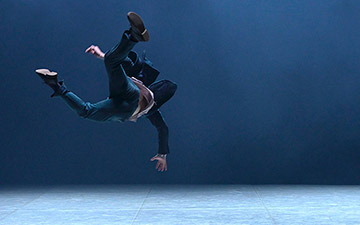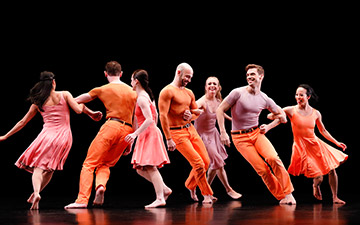
© Alvaro Maldonado. (Click image for larger version)
Pasodos Dance Company
El Principito
★★★★✰
Palma, Teatre Principal
27 November 2016
www.facebook.com/pasodosdancecompany
The Little Prince (El Principito) passed my childhood by, whizzing over my consciousness much like the aeroplanes flown by its author; the pioneering aristocratic aviator, Antoine de Saint-Exupéry. His surreal novella is the fourth-most translated book in the world and considered to be the best-known French book of the 20th century.
That such an important work of literature has had little impact on the world of dance says much about the difficulty in representing the story of a little prince who, having fallen to earth from a tiny asteroid, the size of a house, meets a pilot in the desert and – over the course of several days – recounts the story of his life, focusing upon his travels to six other asteroids, each of which is inhabited by a single adult with some strange trait.
Although ostensibly a children’s story, El Principito is a philosophical fable, parodying the world at war during the time that Saint-Exupéry was writing (1942) and it is also to some extent autobiographical, since the author had – eight years’ previously – crashed his aeroplane in the Libyan Desert. He survived for four days with little to eat or drink and suffered from hallucinations. Saint-Exupéry died just months after the publication of his masterpiece and although he never admitted to hallucinating, in the desert, about a little prince that had fallen to earth from an asteroid, it makes for an intriguing possibility. Many commentators have suggested that Saint-Exupéry was, in fact, his own inspiration for both the little prince and the pilot.
Pasodos Dance Company – the leading dance company on the beautiful island of Mallorca – has cleverly mixed fact with fiction in their delightful interpretation of El Principito. It seems to begin and end in the home of the author around the time of the novella’s publication. Saint-Exupéry – then aged, 43 – was petitioning to be allowed to resume flying operational missions with the Free French Air Force despite being in so much pain from previous crash injuries that it was reported he could no longer dress himself unaided. And, it is in this incapacitated state that we first encounter the armchair-bound pilot (portrayed by Pasodos co-founder, Gavin De Paor), surrounded by his family, apparently receiving an affirmative response to his petition to go back to the war. In keeping with the ambiguity of the novella, there could, however, be an alternative interpretation of this opening scene, to represent an extension of the fiction as the home of the aging pilot/narrator. Either way, it is an effective beginning, employing contemporary film of wartime aircraft leading to the desert crash.

© Alvaro Maldonado. (Click image for larger version)
A young boy is present in the pilot’s home, perhaps the fictitious pilot’s grandson (since Saint-Exupéry was childless), played by seven-year-old, Liam De Paor (the son of Gavin De Paor and Laura Macias). The titular prince is portrayed by French dancer, Stéphane Arestan-Orré. He started a little hesitantly – perhaps, following an infinitesimal slip on his entrance – in an opening solo to Camile Saint Saens’ Danse Macabre (now well-known as the theme to the Jonathan Creek TV series), but Arestan-Orré quickly settled in to his gruelling set of quirky encounters that comprised the core of the work’s 65 minutes.
The opening sequence of the pilot and little prince coming to a mutual understanding through their interpretations of drawings (a boa constrictor eating an elephant and a sheep inside a box) is well articulated. This rich clarity extends unabated into el principito’s account of his journeys to the other asteroids and their mysterious inhabitants: the vain king who rules over no subjects (a charismatic and sardonic performance by Liam Giacuzzo, posturing as if the Sun King himself); a geographer who knows nothing about geography because she is not an explorer and never leaves her desk, cleverly represented through a tango-based pas de trois for the pilot (De Paor), the geographer (slinky Nuria Cazorla) and a moving desk; Giacuzzo returned as the alcoholic who is so ashamed of being drunk that he drinks in order to forget, his comic routine punctuated by fouettés and ending by being carried off from an over-enthusiastic curtain call; a merchant (Stephanie Carpio) who relentlessly counts the stars in order to “own” them, rather than simply appreciate their beauty, a sequence represented in a tightly-controlled corps dance to Balkan-themed tango; and, a lamplighter (Giacuzzo, again) who routinely follows orders to continuously light and then extinguish his lamp, using the lamppost variously as a lever, a pogo stick and a weightlifting bar; concluding with another fine classical dance for the small corps de ballet, clad all in white, topped off by a brief athletic solo for Joan Horrach.
In amongst these allegorical stories, the little prince returns to a mysterious rose – in a softly romantic duet for Arestan-Orré and Carpio – that accompanied him from his asteroid home (in Saint-Exupéry’s imagination the rose is said to have represented his wife, Consuelo, played by Macias, and it is suggested that the tiny home, volcanic asteroid may identify with Consuelo’s home country of El Salvador). Cazorla danced the snake (in a black unitard slashed with green stripes) that offers to bite the little prince so that he can return home to his asteroid in a climactic, serpentine pas de deux.
De Paor, the elder, is an Irishman who has ended up in Mallorca by way of the famous Perm Ballet School and stints as a soloist in ballet companies around Russia – including Moscow City Ballet – and central Europe, where he met Macias, a native Mallorcan, dancing at the Flensburg Ballet in Schleswig-Holstein. His direction for El Principito is well-paced; the set transitions are quick and cloaked by the action on stage, which includes effective uses of black theatre lighting techniques to show silhouetted action on the backdrop.
Macias’s choreography is a smart cocktail of classical movement mixed with modern accents to establish characterisations that fit Saint-Exupéry’s ideals. There are numerous dances for the multi-purpose cast of 13, switching quickly, for example, from a duet to a quartet, often involving some of the same dancers. Macias also portrays the fox that helps el principito come to terms with the discovery that his rose is not unique in an athletic pas de deux (with Arestan-Orré) that involves Macias cart-wheeling into a six o’clock extension and being levered over his shoulders.

© Alvaro Maldonado. (Click image for larger version)
De Paor, the younger, returns for a final duet with Arestan-Orré – making sure that this busy dancer performs with the whole of the rest of the cast – emerging from the well that signifies hallucinations that end the little prince’s tenure on earth, although there is still time for another brief duet with his father, while the asteroid inhabitants are reprised in black light, and before the plane flies, once more.
De Paor’s direction is surprisingly anglophile. The production opens with an imitation of BBC newsreel wartime announcements (including one about the disappearance of Saint-Exupéry’s aeroplane) and video backdrops that evoke the allied environment of WW2. The more surprising aspect is that the narration prior to each scene continues in English; and this, for a work that has, thus far, only toured in Spain; although I suspect that the use of English precluded a difficult political choice between Catalan and Spanish.
I first encountered Pasodos Dance Company at the Edinburgh Fringe, more than a decade ago, performing an excellent piece entitled The Tango Spell and tango music also infuses this production, notably in a compilation of numbers from the Argentine band, Amores Tangos; augmented for formality by snippets of The Planets. The music is well-chosen to help illustrate and describe the action and Daniel Noceda’s lighting design is also key to bringing elements of Saint-Exupéry’s story to the stage with appropriate effect.
Costume designs by Marta Mimó capture the spirit of Saint-Exupéry’s illustrations; and Andrew Donovan’s set designs are excellent, especially given the limited resources at this company’s disposal. The concept of a plane, crashed in the desert, is well conveyed, but simply, and the imagery of the plane – now repaired – taking off and about to fly out into the auditorium with the young De Paor on board is a cleverly-realised stunt with which to end the ballet.
Prior to this final scene came an epilogue back in Saint-Exupéry’s drawing room, but with his armchair empty. The author disappeared, somewhere in the Mediterranean Sea off the coast near Marseilles, at the end of July 1944. It is a poignant ending to an excellent capsule ballet and a rollercoaster story that should appeal to young and old, alike.

















You must be logged in to post a comment.